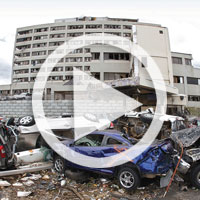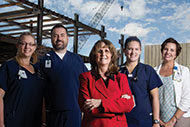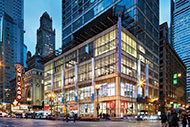
View "Resilient health care design" Gallery
When catastrophe strikes, one service a community can’t lose is the hospital. Health care organizations must continue to operate in a crisis. This is a matter of patient safety, business continuity and public service, says Doug Erickson, FASHE, CHFM, HFDP, CHC, chair of the Health Guidelines Revision Committee, which oversees the Guidelines for Design and Construction of Health Care Facilities.
Past storms and earthquakes with names that read like a rogues’ gallery of ruin — Sandy, Isaac, Ike, Katrina, Allison, Northridge and Andrew — have shown how important it is for certain hospital buildings to withstand high winds, flooding or seismic activity. In a practice known as “resilient design,” health care design and construction professionals are drawing on these experiences to develop facilities made to resist a variety of natural or human-induced disasters and to recover quickly afterward.
“That’s a new term we’re using in health care now, since Sandy,” says Mark Kenneday, CHFM, FASHE, vice chancellor for campus operations at the University of Arkansas for Medical Sciences in Little Rock. Recovery costs to the New York health care sector following Hurricane Sandy in 2012 were estimated at $3.1 billion, highlighting the importance of this issue.
But it’s a question the health care community has been engaged with for some time, Kenneday notes: How do you harden facilities to ensure that operations can persist, millions of dollars and years of research aren’t lost and health care is maintained under almost any circumstances, without breaking the bank?
Health care organizations that have weathered catastrophes are showing how by rebuilding facilities stronger and better than they were.
Storm ready
Mercy, a health system based in St. Louis, is aiming for similar success with the design of Mercy Hospital Joplin (Mo.), scheduled to open in March. This building is a replacement facility for St. John’s Regional Medical Center, which was blown apart by a direct hit from a tornado in 2011.
“After seeing the devastation of the earlier facility, it was important to Mercy to do whatever we can to ensure we’re here” for the Joplin community, says John Farnen, the health system’s executive director for strategic projects. The goal is to create a facility that stays operational throughout major storms, says Ryan Felton, LEED green associate, project director, McCarthy Building Cos., St. Louis.
The new building has a precast exterior and a multilayer roof system constructed of lightweight concrete atop a metal deck. Precast material and concrete roofing on the previous facility withstood the forces of the 2011 tornado fairly well, according to project team members. In fact, says Tim Solohubow, AIA, principal and senior vice president, HKS, Dallas, a wrecking ball bounced off the precast several times at the start of the old facility’s demolition.
Laminated glass in the previous hospital’s behavioral health unit also held up to the tornado. The new hospital has a specially designed glazing system featuring laminated glass throughout, with glass rated for 140-mph winds in areas from which patients can be moved during a storm and glass rated for 250-mph winds in the intensive care units. Storm-resistant doors and door hardware provide additional protection at the hospital’s main entrance and the entrance to patient floors.
During the tornado, an air-handling unit was tossed off the hospital roof and crushed a metal building that housed the switchgear associated with the generators, leaving the facility with no emergency power. A new central energy plant with concrete walls and minimal openings is buried halfway underground about 400 feet away from the hospital building. The plant is connected to the hospital by a utility tunnel about 25 feet below grade. In addition to redundant electrical sources — one from the north and one from the south — the hospital has enough generator capacity on-site to operate 96 hours without a fuel delivery, says Farnen. Plus, a portable uninterruptible power supply system can run all life-support equipment for up to two hours, the amount of time it took to evacuate the entire facility in the aftermath of the tornado.
Upgraded communications equipment and a basement “war room” are included in the new building to help manage severe weather events. The entire design is meant “to protect workers, patients and visitors so they feel safe in the facility,” says Farnen. It does so without compromising the aesthetics of the Mercy brand, adds Solohubow.
High and dry
When a storm surge breached the levees of St. Bernard Parish, Chalmette, La., the day after Hurricane Katrina hit New Orleans in 2005, Chalmette Medical Center was flood-damaged to the extent that the building ultimately had to be demolished. The community’s replacement facility, St. Bernard Parish Hospital, is designed to withstand future storms.
Originally three feet below sea level, the new hospital site was raised four feet to mitigate annual flood risk. To further protect key infrastructure components, all critical operating equipment, including air handlers, boilers, the fuel tank and switchgear, are on the hospital’s second floor, 16 feet above the base-flood elevation. Should another flood occur, “you could gut the first floor entirely and still run the hospital,” says Phil Wendling, senior project executive from the Dallas office of health care consulting firm Hammes Co.
The hospital’s first floor is constructed of fairly standard health care interior materials, such as gypsum board, that will be easy to tear out if necessary, says Robert Hamby, AIA, NCARB, EDAC, LEED AP, senior associate, health care, Gresham, Smith and Partners, Nashville, Tenn. The only major loss the hospital would experience if water inundated the first floor would be the equipment in the imaging department.
Hamby says the project team undertook a long process before deciding to accept this risk. Possible equipment replacement was balanced against the higher cost of placing such heavy, complex machinery on the second floor. In addition, the hospital did not want to sacrifice patients’ ease of access to the first-floor imaging department. In case of emergency, the loading dock is designed to support mobile imaging services. “Any modality they need can be brought in [on a temporary basis],” Hamby explains.
To protect against strong winds and projectiles, the hospital features high-strength, hurricane-rated glass installed in deep window frames that will prevent the windows from falling out and becoming hazards even if they crack. Windows on the third floor open to allow rooftop access — it was necessary to break windows for helicopter evacuations following Katrina.
The hospital has two large, dual-fuel generators that can power the entire building for five days or be used to stage critical areas for a longer run time in a crisis. This, too, is based on a lesson from Katrina. After that storm, it took five or six days for fuel trucks to reach the area.
Hurricane Isaac struck St. Bernard Parish in August 2012, one month prior to the hospital’s grand opening. As the storm bore down on the Gulf Coast, “I think everybody was crossing their fingers,” says Hamby. “But the building did great.” Despite extensive local power outages, high winds and flooding, the facility experienced only one small leak.
‘Wash and wear’
In 2008, a storm surge caused by Hurricane Ike sent 13 feet of water through University of Texas Medical Branch (UTMB) facilities in Galveston, causing $1 billion dollars’ worth of damage. UTMB was forced to evacuate students, patients and noncritical staff and to remain closed for a month. For a time, it was uncertain whether the university would rebuild the campus. But in the words of past university regent Beauregard Bryan, commenting on a 1900 hurricane, “The University of Texas stops for no storm.”
To ensure that this remains the case, UTMB developed a plan to “design and construct a resilient campus capable of recovering from a weather event independent of federal response.” The plan involves raising mission-critical functions to locations above 20 feet in existing buildings and above 25 feet in new construction. In addition, all buildings are to be designed for a minimum wind speed of 132 mph.
The first-floor concourse that connects 11 facilities on campus has been rebuilt according to the Federal Emergency Management Agency’s wet flood-proofing method. To implement this “wash-and-wear” design, as the UTMB project team calls it, materials that can resist water damage were installed. The concourse walls are backed with cement board and faced with tile. The flooring is terrazzo, with a precast terrazzo base. The doors are made of fiberglass-reinforced plastic that can withstand water without developing mold or rust.
“Basically, we can accommodate water coming through. Then we would dry out the building and we would open back up. So it’s not going to shut us down,” says Patrick M. Casey, AIA, regional program manager for Galveston in the University of Texas System’s office of facilities planning and construction.
The design of UTMB’s Jennie Sealy Hospital, a replacement facility scheduled to open this year, follows the same resiliency principles. All critical functions are located above 25 feet, including the emergency department (ED), which is accessible via a ramp. First-floor utilities function independently from the rest of the building. The exterior façade is being commissioned to make sure it can withstand winds up to 160 mph and resist water and air infiltration from driving wind and rain. The hospital infrastructure features N+1 redundancy (“we have backup generators for our backup generators,” Casey explains). There is a dedicated gas main leading to the hospital, and a dedicated water tower serves the medical campus. Two cogeneration plants are planned to go online in 2016. “All of these decisions are related to the environment of care and patient safety,” says Casey. He says the university intends to maintain a healing environment in its facilities regardless of the conditions outside.
Flood insurance
NYU Langone Medical Center, New York City, is undertaking similar efforts to protect key facilities and infrastructure from severe weather. Flooding from Hurricane Sandy caused a loss of backup power at the medical center, leading to the evacuation of patients during the storm.
Afterward, the medical center’s ED was closed for 18 months to fast-track repairs, as well as renovations that already were underway. To improve the resiliency of the structure, walls surrounding the ED were reinforced and waterproofed against a storm surge even higher than that experienced with Hurricane Sandy. The Ronald O. Perelman Center for Emergency Services opened last April.
Other parts of a campuswide mitigation plan include the construction of a flood-wall system to protect the campus perimeter. A 7,500-kilowatt emergency power system for the medical center’s Tisch Hospital has been installed on the third floor of an energy building that is under development on campus. A cogeneration plant in the energy building will provide 10.5 megawatts of power and meet 100 percent of the campus steam requirements. The plant is scheduled to be ready for emergency use this year. When the energy building is completed in 2016, its systems will enable NYU Langone to maintain power independently to all key operational components — a capability the medical center terms “island mode.”
In addition, this year NYU Langone expects to complete the elevation of Tisch Hospital’s critical infrastructure and medical equipment, such as magnetic resonance imaging machines and a linear accelerator, above the region’s 500-year flood level, a flood that has a 0.2 percent probability of happening in a given year. The medical center plans to raise the critical infrastructure for remaining campus buildings to this level by 2016.
“We want to make sure we’re prepared for anything … and ensure that we’re providing a safe environment,” says Paul Schwabacher, PE, senior vice president, facilities management, real estate development and facilities, NYU Langone.
A logical response
Resilient design is a logical response to natural and human-induced disasters faced by hospitals in many regions of the country.
At its most fundamental level, Schwabacher says, resilient facility design is important because people’s lives depend on it.
Amy Eagle is a freelance writer based in Homewood, Ill., who specializes in health care-related topics. She is a regular contributor to Health Facilities Management.
More lessons learned from past disasters
Designers and builders in regions of the country at high risk for earthquakes or hurricanes have been working to create resilient health facilities for many years. Lessons learned from these areas are informing projects across the nation as interest in resilient design grows.
In California, loss of life and damage to hospital buildings during the 1971 San Fernando earthquake and the 1994 Northridge earthquake led the state to adopt seismic safety standards intended to ensure that hospitals remain intact and capable of providing acute care after a seismic event.
People need a functioning hospital when everything else is in chaos, says Arlee Monson, AIA, principal in the San Francisco office of SmithGroupJJR and a member of California’s Hospital Building Safety Board.
There are a variety of structural designs for earthquake resistance, including braced framing, in which a facility’s vertical supports are buttressed by diagonal braces, and base isolation, in which the foundation rests on a system of flexible supports that control how the building moves in shaking ground. For Sacramento, Calif.-based health system Sutter Health’s Van Ness and Geary campus, a hospital under construction in San Francisco, SmithGroupJJR is utilizing a viscous wall damper system designed by the Oakland, Calif., office of Degenkolb Engineers to diminish horizontal movement. Monson says this project is the first in California to use this building technology, which is more cost-effective, requires less maintenance and gives designers more architectural freedom than other methods of dealing with seismic concerns.
To reduce damage from flying objects during an earthquake, the Oakland, Calif.-based Kaiser Permanente health system anchors all medical equipment and tethers any mobile equipment large enough to pose a danger in hospitals at seismic risk. For additional protection, Kaiser Permanente uses fire sprinkler systems with flexible piping and connections, seismic shut-off valves on gas lines and N+1 redundant mechanical systems. These measures are important because “hospitals have a central role in a community’s recovery after an earthquake,” says Scott Bell, executive director of facilities, planning and design at Kaiser Permanente.
The Florida building code includes hurricane provisions adopted after Hurricane Andrew hit the state in 1992. Materials like hurricane-resistant glass must be certified to meet the high-velocity standards for Miami-Dade and Broward counties. Matt Manning, AIA, EDAC, senior project designer-manager, Earl Swensson Associates Inc., Nashville, Tenn., says storm-resistant design isn’t limited to the Florida market. In the last several years, a broad segment of the Midwest has become interested in safeguarding against tornado damage. “Clients are starting to ask for spaces that can protect patients,” he says.
Similarly, the firm included steel bracing in the design of Baptist Memorial Rehabilitation Hospital in Germantown, Tenn., which is located near the New Madrid fault line.
In 2001, Mark Kenneday, CHFM, FASHE, led a flood-control project at Texas Children’s Hospital, Houston, that was fully commissioned just 13 days before Tropical Storm Allison caused hospital evacuations and more than $2 billion dollars in damage at Houston’s Texas Medical Center. Thanks to the facility’s successful flood plan, Texas Children’s Hospital was relatively unscathed and remained operational throughout the crisis.
Kenneday is now vice chancellor for campus operations at the University of Arkansas for Medical Sciences in Little Rock. His team has developed a highly efficient, robust and secure utility system to ensure that the entire clinical line will never lose power. Wherever the hospital, whatever the risk, “these strategies really do pay off, big time,” he says.
Merging resiliency with flexibility
Resilient health facilities are designed to handle anything from a sudden catastrophe to long-term changes over the life of a building.
At Major Hospital, a replacement facility due to open August 2016 in Shelbyville, Ind., the project team’s stated objectives are to create a building that is patient-centric, disaster-ready, flexible and energy-efficient. These qualities are intended to complement one another to provide the most effective, responsive care under any circumstances.
The hospital’s physical plant is located on the building’s lower level to keep this equipment safe during a tornado. The 12-inch thick concrete basement walls, which are hardened against severe weather, are uninterrupted; to prevent flooding, there is no loading ramp leading to the basement. Richard Fetz, AIA, ACHA, executive architect, Major Hospital, says a ramp of this sort can serve as “an interstate highway for water” during heavy rain. The mechanical penthouse at the top of the building is completely enclosed and resistant to damage from weather and high-velocity penetration. Windows are reinforced with protective film.
The building has 100 percent emergency power, redundant heating and cooling and redundant information technology connectivity. The building also has emergency connections to allow trailer-mounted equipment to be hooked up for temporary use, if needed. “We took a belt-and-suspenders approach,” to maintaining critical functions, explains Jeff Williams, vice president of facility operations, Major Hospital, noting that this is the only hospital in Shelby County.
To ensure that the building continues to meet the community’s growing needs, expansion zones and shell space are included in the design.
Northwestern Medicine’s 259 E. Erie St. building, an outpatient surgery center and patient care pavilion that opened in Chicago last October, was designed with a similar eye toward strength and flexibility.
The building’s dense, urban site provides stable utility service, including four separate circuits from Commonwealth Edison, the local energy provider. Utility vaults on a number of floors in the building ensure that only a portion of the facility would be affected by a transformer failure. Plus, the building has enough generator power to maintain operations to include chilled water production during a prolonged utility outage, even if its entire chiller plant goes down. An uninterruptible power supply is dedicated to information technology services like medical records and communications. “Communications are critical for health care operations,” says Paul Petska, principal, Affiliated Engineers Inc., Chicago. This is true even if all else fails, and a facility has to be evacuated, he notes.
In addition to these resiliency features, the building is designed on a universal grid that can support a variety of uses, from offices to operating rooms. During the design process, the project team worked though the most likely health care scenarios and developed a database of room types Northwestern Medicine can draw from over the years as needs change.
Resiliency goes beyond disasters or forces that may act on a building, says Randy Guillot, design principal, from the Chicago office of CannonDesign. “Buildings [often] become rubble because they become obsolete. We would prefer that buildings be able to extend their useful lives as long as possible,” he says.





